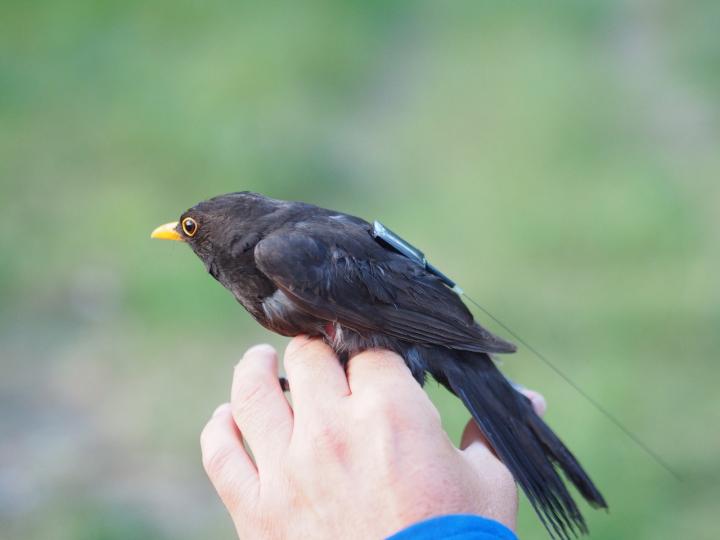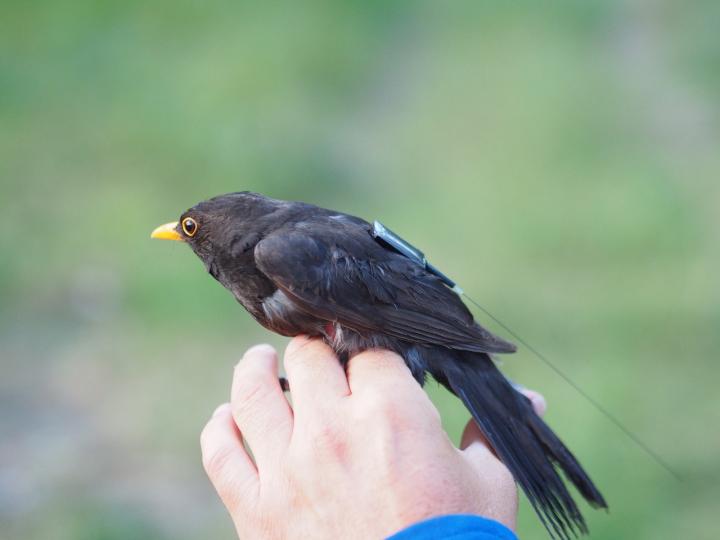
Credit: Max Planck Institute for Ornithology
New Haven, Conn. – The International Cooperation for Animal Research Using Space, or ICARUS, will be flying closer to the sun than ever when a pair of Russian cosmonauts installs the antennae for its state-of-the-art animal tracking system on the exterior of the International Space Station on Aug. 15. The installation will be one small step for the cosmonauts and one giant leap for Yale biodiversity research.
Thanks to the recently founded Max Planck-Yale Center (MPYC) for Biodiversity Movement and Global Change, Yale and U.S.-based biodiversity researchers will be among the first to make use of the big data that this groundbreaking scientific instrument will be collecting by early 2019.
For the past 16 years, ICARUS has been simultaneously developing the tiniest transmitters (by 2025, the team hopes to scale down solar-powered backpacks enough to fit them on desert locusts) and some of the most massive antennae (the equipment that the cosmonauts will be installing). Together, these two new technologies will give biodiversity researchers an unprecedented, extraterrestrial perspective on the lives of some of Earth's smallest and most mobile creatures, such as fruit bats, baby turtles, parrots, and songbirds.
"The system represents a quantum leap for the study of animal movements and migration, and will enable real-time biodiversity monitoring at a global scale," said Walter Jetz, professor of ecology and evolutionary biology at Yale and co-director of the MPYC.
"In the past, tracking studies have been limited to, at best, a few dozen simultaneously followed individuals, and the tags were large and readouts costly," added Jetz. "In terms of scale and cost, I expect ICARUS to exceed what has existed to date by at least an order of magnitude and someday potentially several orders. This new tracking system has the potential to transform multiple fields of study."
Even with the limited tracking technology available, biodiversity researchers have already been able to predict volcanic eruptions by tracking the movements of goat herds and understand impacts of climate change by following migration changes in birds. This new space station-based system will allow researchers to see "not only where an animal is but also what it is doing," explained Martin Wikelski, chief strategist for ICARUS, director of the Max Planck Center for Ornithology, and co-director with Jetz of the MPYC.
"At a global scale, we will be able to monitor individual animal behaviors as well as get a grasp of their intricate life histories and interactions with each other," said Wikelski. In addition to positional coordinates, the transmitters are able to capture each animal's acceleration, alignment to the magnetic field of Earth, and moment-to-moment environmental conditions, including ambient temperature, air pressure, and humidity.
The technology provides an exciting tool to monitor changing wildlife and the connectivity of landscapes for conservation and public health, explained Jetz. Researchers will be able to apply this new language of mass animal movement to everything from greater forewarning of geological disasters, such as earthquakes and volcanic eruptions, to monitoring the next potential disease outbreak in humans. For example, Wikelski plans to use the new system to advance his own project of tracking the movement of African fruit bats as sentinels for finding the hosts of the Ebola virus. (Fruit bats have antibodies against, but do not transmit, this deadly disease.)
"Tracked animals can act as intelligent sensors and biological sentinels and in near real-time inform us about the biodiversity effects of ongoing environmental change," explained Jetz.
By the beginning of 2019, Wikelski and colleagues will have 1,000 transmitters in the field, but eventually, they hope to grow that number to 100,000. Every time a transmitter enters the International Space Station's beam — roughly four times daily — it may send up a data packet of 223 bytes. From there, the data will be relayed back to the ground station and subsequently distributed to research teams. All data — except sensitive conservation data such as rhino locations — will also be published on the publicly accessible database MoveBank, and will inform maps and trends in Map of Life, a web-based initiative headed by Jetz that integrates global biodiversity evidence.
As with all fields of scientific research, however, the data are only as good as their processing and analysis. MPYC will be the primary initial interpreter of the big data harvested by the ICARUS satellite. Fortunately, Jetz notes, with Yale's investment in integrative data science as a research priority, MPYC can handle the big data sets that the ICARUS tracking system generates.
"Going back to my own Ph.D. work observing and tracking nocturnal birds in Africa with much inferior technology," said Jetz, "I was always driven by the wish to document and understand biodiversity from the level of the individual up to the global scale."
"The new technology will allow us to put the bigger picture together," Jetz continued. "Thanks to the near-global scale of ICARUS and satellite-based remote sensing of the environment, we are finally able to connect individual behaviors and decisions with the use of space and environments at large scales. Our collaboration with Max Planck and ICARUS is a wonderful enabler of and complement to our work at Yale."
###
Click here for a video by the Max Planck Institute for Ornithology about ICARUS: https://youtu.be/e_KNyhQMjOY
Media Contact
Kendall Teare
[email protected]
203-836-4226
@yale
http://www.yale.edu





